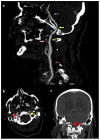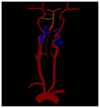Bilateral persistent primitive hypoglossal arteries associated with unilateral symptomatic carotid thromboembolism
- PMID: 28567180
- PMCID: PMC5439450
- DOI: 10.3941/jrcr.v11i4.3010
Bilateral persistent primitive hypoglossal arteries associated with unilateral symptomatic carotid thromboembolism
Abstract
We report the fifth case of bilateral persistent primitive hypoglossal arteries in the literature. This is also the first such case to be demonstrated on computerized tomography angiogram (CTA) and the first case to be associated with a symptomatic carotid thrombus. The sub-occlusive thrombus was distal to the take-off of the dominant persistent hypoglossal artery (PHA) from the internal carotid artery, thus sparing involvement of posterior circulation. Timely identification of the internal carotid artery thromboembolism in the setting of a PHA is important to allow for thrombectomy. Any intervention was not done in this case as the patient was out of the window and at an additional risk of inducing intracranial thromboembolism. Symptomatic carotid stenosis at the PHA take-off is typically treated with endovascular angioplasty and stenting due to the typically high level of the bifurcation in the neck.
Keywords: Bilateral persistent hypoglossal artery; carotid thromboembolism; computed tomography angiogram; endovascular stenting; fetal variant.
Figures






Similar articles
-
Stenting for Internal Carotid Artery Stenosis Associated with Persistent Primitive Hypoglossal Artery Using Proximal Flow Blockade and Distal Protection System: A Technical Case Report and Literature Review.J Stroke Cerebrovasc Dis. 2016 Jun;25(6):e98-e102. doi: 10.1016/j.jstrokecerebrovasdis.2016.03.026. Epub 2016 Apr 19. J Stroke Cerebrovasc Dis. 2016. PMID: 27105567 Review.
-
Symptomatic internal carotid artery stenosis in the presence of a persistent primary hypoglossal artery.Vascular. 2021 Aug;29(4):543-549. doi: 10.1177/1708538120966514. Epub 2020 Nov 11. Vascular. 2021. PMID: 33175663
-
Internal carotid artery stenosis with persistent primitive hypoglossal artery treated with carotid artery stenting: A case report and literature review.Neuroradiol J. 2016 Apr;29(2):115-21. doi: 10.1177/1971400915626427. Epub 2016 Jan 29. Neuroradiol J. 2016. PMID: 26825135 Free PMC article. Review.
-
Endovascular treatment of acute atherothrombotic internal carotid artery occlusion associated with persistent primitive hypoglossal artery.Clin Neurol Neurosurg. 2024 Mar;238:108179. doi: 10.1016/j.clineuro.2024.108179. Epub 2024 Feb 16. Clin Neurol Neurosurg. 2024. PMID: 38387238
-
Concomitant asymptomatic internal carotid artery and persistent primitive hypoglossal artery stenosis treated by endovascular stenting with proximal embolic protection.J Vasc Surg. 2016 Jan;63(1):237-40. doi: 10.1016/j.jvs.2014.04.066. Epub 2014 May 28. J Vasc Surg. 2016. PMID: 24877853
Cited by
-
Variant of a persistent hypoglossal artery supplying only the posterior inferior cerebellar artery diagnosed by magnetic resonance angiography: a case report.Surg Radiol Anat. 2018 Jul;40(7):807-810. doi: 10.1007/s00276-018-1970-z. Epub 2018 Jan 12. Surg Radiol Anat. 2018. PMID: 29330558
-
Bilateral persistent hypoglossal arteries: a case report and literature review.Surg Radiol Anat. 2019 Sep;41(9):1083-1085. doi: 10.1007/s00276-019-02243-6. Epub 2019 Apr 23. Surg Radiol Anat. 2019. PMID: 31016350 Review.
-
Bilateral persistent primitive hypoglossal artery presenting with hemiplegia✰.Radiol Case Rep. 2018 May 22;13(5):1072-1075. doi: 10.1016/j.radcr.2018.04.022. eCollection 2018 Oct. Radiol Case Rep. 2018. PMID: 30228846 Free PMC article.
-
Posterior fossa transient ischemic attack in the setting of bilateral persistent hypoglossal arteries: A case report and literature review.Medicine (Baltimore). 2021 Nov 12;100(45):e27875. doi: 10.1097/MD.0000000000027875. Medicine (Baltimore). 2021. PMID: 34766601 Free PMC article. Review.
References
-
- Uchino A, Saito N, Okada Y, Kozawa E, Nishi N, Mizukoshi W, Inoue K, Nakajima R, Takahashi M. Persistent hypoglossal artery and its variants diagnosed by CT and MR angiography. Neuroradiology. 2013 Jan 1;55(1):17–23. - PubMed
-
- Karasawa J, Kikuchi HA, Furuse SE, Sakaki TO, Yoshida YA, Ohnishi HI. Bilateral persistent carotid-basilar anastomoses. American Journal of Roentgenology. 1976 Dec 1;127(6):1053–6. - PubMed
-
- Murayama Y, Fujimoto N, Matsumoto K. Bilateral persistent primitive hypoglossal arteries associated with a large ruptured aneurysm on one side. Surgical neurology. 1985 Nov 30;24(5):498–502. - PubMed
Publication types
MeSH terms
LinkOut - more resources
Full Text Sources
Other Literature Sources

